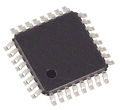The Birth of Integrated Circuits
Integrated Circuits Invented
 Third generation modern computers used what is called integrated circuits (IC's) instead of individual transistors. A great example of an IC is your own computer’s microprocessor such as one made by Intel or AMD. Third generation modern computers used what is called integrated circuits (IC's) instead of individual transistors. A great example of an IC is your own computer’s microprocessor such as one made by Intel or AMD.
Microprocessors are complex IC's and they process information in your computer just like your own brain processes information for yourself.
The first integrated circuit was created in 1958 by Jack Kilby, an engineer working at Texas Instruments. This great invention proved that both resistors and capacitors could exist on the same semiconductor material.
In 1959 just about six months later a man named Robert Noyce also from Texas Instruments came up with his own idea for the integrated circuit. Robert Noyce’s integrated circuit solved many of the problems that Kilby’s circuit had such as the problem of connecting all components on the chip itself.
By adding metal as a final layer and removing some of it, wires were formed in turn connecting all the various components. Pretty cool! Because of this revolutionary invention integrated circuits could now be mass produced.
The Inner Workings
 Integrated circuits in a nutshell are a very advanced electrical circuit made from various electrical components including capacitors, diodes, transistors, and resistors. Integrated circuits in a nutshell are a very advanced electrical circuit made from various electrical components including capacitors, diodes, transistors, and resistors.
Of all these components the transistor however is the one most responsible for the development of modern day computers.
Transistors are the components that turn electricity on and off just like a light switch. Resistors are used to control the amount of current that can pass by limiting the flow of electricity. Capacitors collect, hold, and release electricity in one giant burst of energy. And finally diodes are typically used to stop electricity under various conditions and then release after these conditions change.
Return to:
Return
from Integrated Circuits to Home Page
Contact us | View site map
|